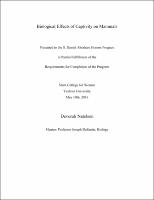Please use this identifier to cite or link to this item:
https://hdl.handle.net/20.500.12202/4064Full metadata record
| DC Field | Value | Language |
|---|---|---|
| dc.contributor.author | Natelson, Devorah | - |
| dc.date.accessioned | 2018-11-05T20:47:01Z | - |
| dc.date.available | 2018-11-05T20:47:01Z | - |
| dc.date.issued | 2016-05 | - |
| dc.identifier.uri | https://hdl.handle.net/20.500.12202/4064 | - |
| dc.identifier.uri | https://ezproxy.yu.edu/login?url=https://repository.yu.edu/handle/20.500.12202/4064 | |
| dc.description | The file is restricted for YU community access only. | - |
| dc.description.abstract | Habitat is the driving force in the evolution of any animal species. Indeed, the evolved animal is a direct reflection of the natural habitat within which it is typically found. In zoos, we remove animals from their natural habitats and put them into ones that are foreign to them. When we place these animals into captivity, there are many biological consequences. Primarily, the animals deal with a lot of stress, resulting in stereotypic behaviors. These behaviors are a reflection of animals’ poor welfare when placed in a captive environment. While zoos do benefit the planet in some ways, these are strongly outweighed by the harm caused to the animals in captivity. | en_US |
| dc.description.sponsorship | S. Daniel Abraham Honors Program | en_US |
| dc.language.iso | en_US | en_US |
| dc.publisher | Stern College for Women | en_US |
| dc.rights | Attribution-NonCommercial-NoDerivs 3.0 United States | * |
| dc.rights.uri | http://creativecommons.org/licenses/by-nc-nd/3.0/us/ | * |
| dc.subject | Captive mammals. | en_US |
| dc.subject | Captive mammals --Behavior. | en_US |
| dc.subject | Captive mammals --Development. | en_US |
| dc.subject | Mammals --Habitat. | en_US |
| dc.subject | Social behavior in animals. | en_US |
| dc.subject | Animal welfare --Moral and ethical aspects. | en_US |
| dc.subject | Crowding stress in animals. | en_US |
| dc.subject | Zoos. | en_US |
| dc.title | Biological Effects of Captivity on Mammals | en_US |
| dc.type | Thesis | en_US |
| Appears in Collections: | S. Daniel Abraham Honors Student Theses | |
Files in This Item:
| File | Description | Size | Format | |
|---|---|---|---|---|
| Devorah-Natelson.pdf Restricted Access | 200.18 kB | Adobe PDF |  View/Open |
This item is licensed under a Creative Commons License

